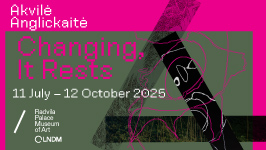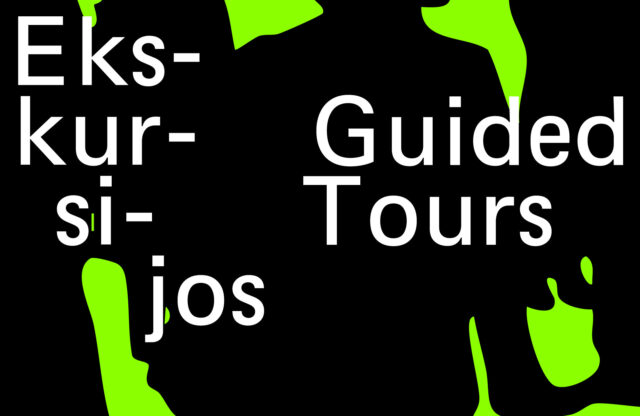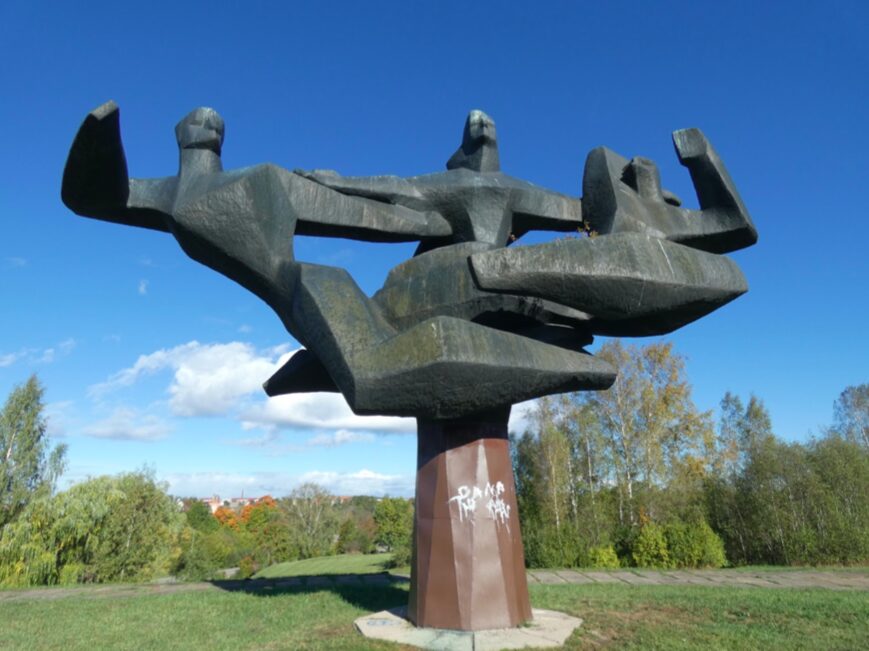My favourite sky comes around this time of year, just before winter begins and after the turn towards warmer weather happens. It’s typified in Tallinn by purple skies; perfect colour fields of a pale lilac. I’ve recently added the pink mornings that graced the Vilnius skies in the few days leading up to the opening of the exhibition to a list of favourite skies. This exhibition, ‘Fragile Balance’ curated by Tallinn based Artist and Curator Kaisa Maasik includes the works of seven artists: Hedi Jaansoo, Nokukhanya Langa, Anna Mari Liivrand, Emma Luukkala, Mari Männa, Laurynas Skeisgiela, Mark Soosaar and currently on view at Atletika Gallery in SODAS 2123, Vilnius. ‘Fragile Balance ‘ as an exhibition feels like a colour: the lilac of the evening or the pink of the morning; they share qualia.
Qualia is defined as the subjective or qualitative properties of experiences, the answer to what it feels like; experientially and how different things have different qualia; seeing a red rose feels different to seeing a yellow rose. Qualia encapsulates the phenomenal properties of experience. Furthermore, experiences that have qualia are referred to as being phenomenally conscious; this in turn contrasts with the idea of intentionality. Qualia is the first piece of text I encountered in my experience of this exhibition; entering Atletika and turning to my right towards one of two paintings by Nokukhanya Langa.

Nokukhanya Langa ‘Nerve Center’ (2023). Mixed media and oil on canvas, 120 × 110 cm. View from the exhibition ‘Fragile Balance’, Atletika, Vilnius, 2023. Photo by Laurynas Skeisgiela
Sitting down to write this I had to look up qualia when I read it. My mind had immediately gone to the recollection of a 2013 exhibition by Boorloo (Perth) based artist Jacobus Capone also named ‘Qualia’. There’s little trace of this exhibition online; I can’t remember if I even saw it or just experienced it through recounts of others. The exhibition’s Facebook event description read “MOANA PROJECT SPACE INVITES YOU TO CELEBRATE THE OPENING OF QUALIA, OUR FINAL EXHIBITION FOR 2013, THIS FRIDAY FROM 6PM.
Qualia is a solo exhibition of new work by internationally renowned Western Australian-born artist Jacobus Capone. Fresh from an exhibition and three-month residency at Flux Factory in New York City, Jacobus will present a meditative and immersive video-based installation that reflects upon our perceptions of the present moment. In what began as a way of quelling his uneasiness at leaving The United States, Jacobus filmed the steadily shifting dusk sky from the vantage of a deserted rooftop each day from 3 August until 21 September 2013. The resultant series of video work tracks sporadically passing aircraft: people arriving and departing from one state to another. In acknowledging the transitory state of all things, Jacobus seeks to question whether the present can ever truly be appreciated or inhabited. Marking a recognition of our perpetual, inescapable habit of filtering and constructing our perceptions of reality. Qualia poses a poignant underlying thought: The moment we are within, as soon as it’s intellectualised, eclipses us.”

Installation view of the exhibition ‘Qualia’ at MOANA Project Space Boorloo, Perth, Australia, 2013. Photo by Jacobus Capone
In bringing up one exhibition held ten years ago to talk about one now, there is relevance. Not only because the balcony I see the pink Vilnius sunrises from is directly along the flight path in and out of Vilnius airport and looking directly towards SODAS 2123, the path I walk under and along to visit the exhibition, but because the questions formulated in this invitation to Capone’s exhibition can shape the discussion surrounding ‘Fragile Balance’.
Can the present truly be inhabited?

Jacobus Capone ‘Qualia’ (2013). Still from video.
I would like to answer this through another question; the question of how the exhibition ‘Fragile Balance’ might be experienced? And to do so, I will dart in and out of references from memory and descriptions of experience (which maybe feels appropriate given the nature of qualia as a phenomenon). And to do so with the aim that this reflects the idea of being both in and being in-between.
“The exhibition Fragile Balance focuses on the relationship between ‘I can’ and ‘I cannot’ – the collision of the frail and the sturdy as something that artists deal with daily, but voice ever so less. Each of the participating artists has created a practice out of their relationship to the material. The chosen matter becomes an extension of the creator themselves and their capabilities. The struggle is kept in motion even after the work has been put out on display. Seemingly effortless, practising fragility demands the same conviction. Balancing between two states – gentleness on the one side, being tough on the other – both are key as it affects the final form and outcome. The fragility of the material and the process connects to the person and their vulnerability and invincibility as a human.” Kaisa Maasik writes in the accompanying handout for the exhibition.

View from the exhibition ‘Fragile Balance’, Atletika, Vilnius, 2023. Photo by Laurynas Skeisgiela

View from the exhibition ‘Fragile Balance’, Atletika, Vilnius, 2023. Photo by Laurynas Skeisgiela
Many of the artists I become familiar with in the exhibition space through the works included in the exhibition , though this is with the key exceptions of Kaisa Maasik and Anna Mari Liivrand, my peers from the Masters of Contemporary Art program at the Estonian Academy of Art. My experience of the exhibition is a blend of my memories of their work, the new details in newly met artworks I’m noticing, my experience of the weather patterns in Vilnius, and my memories of how they compare to this time of year in Tallinn. The same purple favourite sky is also featured in Mark Sosaar’s video and the pink screen that divides the large exhibition hall means that I’m reminded of the same sunrise pink I began my day with.

Mark Soosaar ‘The Dugout Canoe’ (1986). Video, sound, 15′ 23”. View from the exhibition ‘Fragile Balance’, Atletika, Vilnius, 2023. Photo by Laurynas Skeisgiela
Moving from the entrance to the space and into the hallway between both galleries, one question stands or rather floats: will the top of the tower in Laurynas Skeisgiela’s video ever be topped? At the moment you believe it might be, a whistle reverberates connecting one room to another, the sound only stopping when it is evident that this will never happen.

Laurynas Skeisgiela ‘Small Town Murder Songs, excerpt’ (2020). Video projection, 2 C-stand light stands, 6’ 40’’. View from the exhibition ‘Fragile Balance’, Atletika, Vilnius, 2023. Photo by Laurynas Skeisgiela
The whistle comes from the 1986 video work by Mark Soosaar that can be watched while sitting on a bench made by Emma Luukkala.
Although in the days that I sit with this essay the snow has arrived. This morning I thought the snowflakes were confused flies, born in the confusion created by this last summer lingering longer and creeping into what should be autumn. Winter, although tied to the feeling of stillness, is itself a force of change. This is especially evident by the Estonian coast, the freezing of the Baltic sea being the only entity able to move the glacial stones, traveling stones that arrived on their shores with the melting of the last glacier, that same glacier whose edge created the Vilnius Valley. Even trying to encapsulate experiences happens in parallel to the changing of seasons, and so trying to be with a moment is defined and evidenced with the weather-being with a moment means that change is happening. It’s unclear if the video is set coming in or out of winter, the amphibious landscape of Estonia is in both a state of flooding and melting.

View from the exhibition ‘Fragile Balance’, Atletika, Vilnius, 2023. Photo by Laurynas Skeisgiela
The man in the video tells us that the tree must be the right one and also that the tree he fells is the best choice, but none are really good for the job. The tree being the ‘ok’ enough choice suddenly can be a boat. ‘I cannot’ transformed to ‘I can’.
I return to the front room with another realisation that the paintings of Nokukhanya and sculptures of Mari Männa are by different artists. I read the materiality of the sculptures through the materiality of the paintings and in turn through the details of Emma’s work I see a sunrise and a sunset in the second painting by Nokukhanya. Watching the work by Mark on a bench made by Emma you realise that the works don’t only live in the world of each other but you the viewer are invited to be part of this world. Amplification of detail – zooming in and out of ornament, intention and connection – are a state of being central to the work of Anna Mari Liivrand’s works. A practice thus also being able to frame the conceptualisation of the combination of artists / artworks.

View from the exhibition ‘Fragile Balance’, Atletika, Vilnius, 2023. Photo by Laurynas Skeisgiela

Mari Männa ‘All Eggs In One Basket’ (2023). Jesmonite, fiberglass, polyurethane foam, seashells, shells of oysters, 95 × 84 × 35 cm; ‘Rock’ (2019). Papier mache, aluminium net, latex, 78 × 44 × 50 cm. View from the exhibition ‘Fragile Balance’, Atletika, Vilnius, 2023. Photo by Laurynas Skeisgiela

Emma Luukkala ‘Picnic 2’ (2023). Oil on linen, wooden frame, 93 × 83 cm.
This exhibition is in-actuated through the relations of artworks enabled largely in part to the intentionality of Kaisa’s curation. On the last occasion I wrote about group exhibitions; I likened them to the state of the shared house I was living in whilst writing:
“We are five living in my house: We all come and go, crossing over in the morning to share feelings over coffee and maybe catching each other to listen to an anecdote from the other’s days in the evening before bed.
Individuals from different origins living separate lives, with their own lived private experiences, living independently in separate bedrooms and at the same time finding balance and coming to compromise, co-existing within the same building, a shared home. I don’t always know where my housemates are going, or where they’re coming from each day. Yet over time I’ve become aware of patterns of movement throughout the apartment. We’ve become used to each other. Energies oscillate and the manifestation of home is not something that is static, it is an active ongoing process.
This state of being, of living in a shared house, is a moment of coming together within a space as if an exhibition of sorts. Each entity comes from a particular context of origin, and has their own stakes in the world. We as house-mates are not curated to bring about a particular statement. We were thrown into a living situation because we knew someone, who knew someone and needed a room to stay in. This is something different from a commune, or cult – a gesamtkunstwerk or a presentation with a definitive thesis. There is no common manifesto, but we do fit together in dialogue, creating a conversation. This house is a group show, a salon hang. Each individual is an artefact and the juxtaposition of each moment is an accent point that creates something unexpected, generative, experimental and unique.
The shared-house, an exhibition within time: statement points and conflicts (major dramas or explosions of joy) creates fluctuations in an experimental narrative structure, with moments all existing or coming together/separating temporarily. This is an exhibition where sometimes, some things will escape you and yet there is a sense of and investment in a contained whole.”2018
A few years later and with more general optimism I see in ‘Fragile Balance’ the strength that comes from collectivity. There’s something special about looking for similarity, realising that details in artworks are made visible. In other words material perception is shaped by the materiality of other works. I’m met with pleasant surprise when Hedi Jaansoo introduces the pink glass sculpture as one of her works, not as I expected a work of Anna Mari – whose work often includes the same dusty rose colour.

Hedi Jaansoo ‘Nails and Punctures and a Bit of Support’ (2023). Two pigment prints on aluminium composite, metal frames with pink spacers, museum glass, vase, pearls, wire, a dried rose petal. View from the exhibition ‘Fragile Balance’, Atletika, Vilnius, 2023. Photo by Laurynas Skeisgiela
I cannot close without commending Kaisa Maasik for her role as a curator – facilitating the tender relationship between the singular and commanding practices of all artists included within the Atletika Gallery. Kaisa is an artist and a curator; it’s possible to see the practice of imbuing the importance of souvenirs of the hands’ of others in her own creative works. I’m thinking in particular of her series ‘Tomaatti kurkku leipä (Tomato, cucumber, bread)’, comprised of handmade carpets that are amplified versions of found shopping lists; the intimate and everyday list created with a strong intention of nourishing a body, written and forgotten by that same body, and then carefully memorialised by Kaisa’s body, thus creating another human body in the form of a carpet – a carpet that provides warmth for other bodies.

Kaisa Maasik ‘Patate’ (2019). Handstitched text on an IKEA rug based on a found shopping list, 133 × 195 cm. From the series ‘Tomaatti kurkku leipä’. Photo by Kaisa Maasik
It is hard to see qualia and intentionality are binaries when encountering this exhibition. It is with extremely careful consideration that Kaisa is able to build a group exhibition that is a gradient – a single colourfield made from multiple tones; a sky that is seen from home (whatever king of home that might be, whether shared or independently inhabited) that is looked upon both from within and from a distance – an observation that holds possibilities.
“The land of happy to have you been to” or “have you been to the land of happy” the experience of the exhibition ending again with text on one of Nokukhanya’s paintings, leaving me with the realisation that this show is enacted through parallels, projected understanding and the invitation to see connections and to see that connections are open and evolving; greater than the sum of the details included in the exhibition. A “Fragile Balance” located in space and time but also in perpetual motion, inhabited but also without encapsulation.

Nokukhanya Langa ‘Closer to God’ (2023). Mixed media and oil on canvas, 120 × 110 cm. View from the exhibition ‘Fragile Balance’, Atletika, Vilnius, 2023. Photo by Laurynas Skeisgiela
Photo reportage from the exhibition ‘Fragile Balance’ at Atletika gallery





























